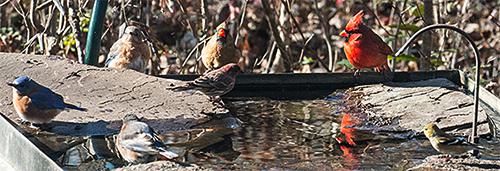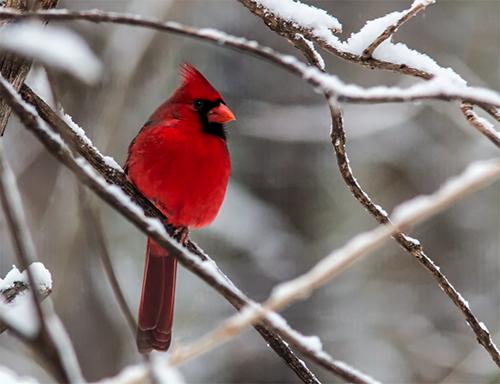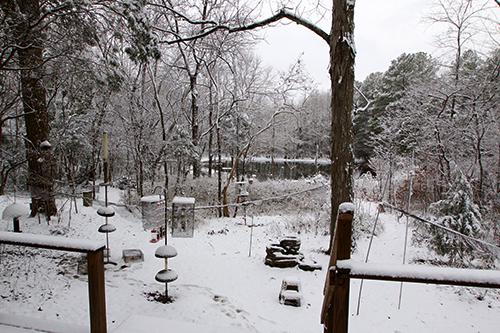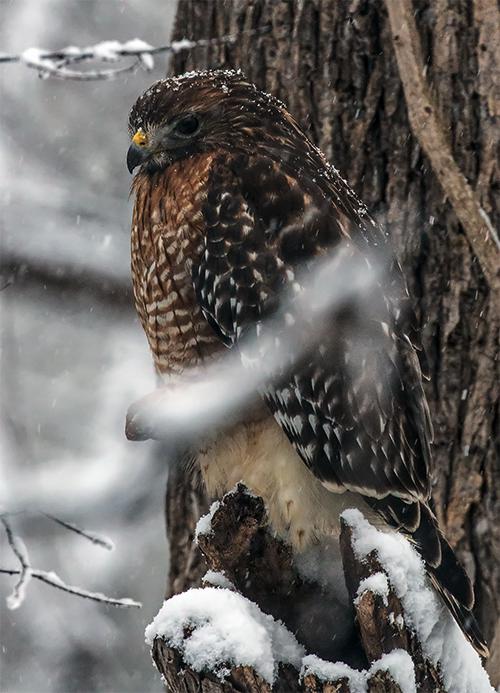|
HOME: www.hiltonpond.org |
|||
THIS WEEK at HILTON POND Subscribe for free to our award-winning nature newsletter (Back to Preceding Week; on to Next Week) |
JANUARY 2018: Happy Natural New Year to everyone from all of us at Hilton Pond Center! Please read on for a potpourri of nature news from January 2018. -- WINTER WATER -- After an overnight low in the 'teens it never got above freezing New Year's Day on the Center's weather station thermometer; despite the wind and brutal cold our backyard bird action was very good. We tallied 16 species on 1 January just by looking out the windows of our old farmhouse--a good start for the 2018 Hilton Pond Yard List. Through the years we've documented 171 species on the 11-acre property; our best year was probably 1991 when we banded 95 species and undoubtedly saw quite a few more we didn't write down. (We regret we didn't start compiling our official Hilton Pond yearly Yard Lists until 2008.) Numerous birds were coming to the feeders for New Year's seeds and suet. Even more impressive was the variety that lined up to drink at our heated bird bath. At one point a dozen Eastern Bluebirds were partaking of the unfrozen water source. (Incidentally, the bath is actually the metal base of an old shower stall, sitting on top of a stone-lined well hand-dug a century ago. In warmer weather water drips slowly from the tube at right, each droplet making a "plop" that alerts wildlife to the presence of water.)
All text, maps, charts & photos © Hilton Pond Center As shown in the photo above taken through our office window, various species seemed more tolerant of each other while drinking in very cold weather. This particular image includes (left to right) three bluebirds, a male House Finch, female and male Northern Cardinal, and a female American Goldfinch. Two Yellow-rumped Warblers, an American Robin, and two other cardinals had just departed! The Moral of the Story (and you've heard this from us before): In many locations potable, accessible water is less available than food, so if you REALLY want to help birds and other wildlife make sure you offer water for drinking and bathing YEAR-ROUND. Since water is even less available to birds when it turns to ice, you should save your pennies and get a good thermostatically controlled submersible heater for your bird bath. All text, maps, charts & photos © Hilton Pond Center
All text, maps, charts & photos © Hilton Pond Center -- DEAD THINGS -- All our biology students far and near from years past will understand instantly why we're posting the above meme to our Web site for Hilton Pond Center. For some it will bring back strong memories . . . perhaps of strong odors. We always said nothing offers a better teaching-learning experience than a fresh roadkill! (We are reminded some parents reportedly carried plastic bags and shovels in their car trunks just so their offspring could turn in a dead animal or two for class credit.)
All text, maps, charts & photos © Hilton Pond Center Of many, two particular roadkill stories stand out from those biology teaching days. The first was at Fort Mill (SC) High School when a student brought in a still-warm Virginia Opossum, Didelphis virginiana, one morning before school. A quick examination revealed it was a female--and she had a half-dozen lightly furred young in her pouch! We were able to save one female joey--the actual name for baby 'possums--that multiple students bottle-fed until she could eat dog food and become old enough for release back into the wild. (The photo above shows Bozeline, the fast-growing young 'possum, with our beloved student Kathy Williams, aka KWms.) Examination of stomach contents of the deceased adult female 'possum showed she was omnivorous, with blackberry seeds, insect parts, and mouse bones as evidence
All text, maps, charts & photos © Hilton Pond Center The second roadkill event involved a full-grown male Raccoon, Procyon lotor, that must have weighed 20 pounds. Seizing the opportunity, we performed a dissection for our tenth grade biology classes at Northwestern High School in Rock Hill SC. Happily, there was no odor because the 'coon again was very fresh--AND there was none of that annoying formaldehyde stench that comes with preserved specimens. Our excited, enthralled students were astounded by the jumble of organs within the Raccoon's body cavity. When one curious young man asked how long the animal's digestive tract might be it was a simple matter of stretching it across the classroom and measuring with a meter stick. Stomach to rectum the intestines came to about six meters--more than 18 feet! (NOTE: Lest you be alarmed, we did take precautions when handling and dissecting various roadkills by wearing surgical gloves and masks and disinfecting everything afterwards. No students were harmed during these unforgettable classroom demonstrations!) All text, maps, charts & photos © Hilton Pond Center -- DEFERRED GRATIFICATIOMN -- And speaking of students from days gone by, it's always gratifying to hear on Facebook from young people who sat in our classrooms and labs, or who we mentored through the years on various projects. We're been pleased to learn a significant number of them have gone on to careers in science and/or education fields.
All text, maps, charts & photos © Hilton Pond Center One of them, Will Daniel--an enthusiastic member of our very first Advanced Placement Biology class in 1982-83 at Northwestern High--now lives in Colorado. He was back home for the holidays this year and gave us a call, indicating his desire to bring his two sons to meet us and to see how the property around Hilton Pond had changed in 35 years. (Coincidentally, Will's father Bill was our independent study professor at Winthrop College for two philosophy courses!) In the photo above younger son Alex is about to release a banded male House Finch; the group selfie was taken by elder son Liam, in blue. Will now teaches high school social studies and fully understands what we mean when we say we have no FORMER students. All text, maps, charts & photos © Hilton Pond Center
All text, maps, charts & photos © Hilton Pond Center -- KILLDEER ON ICE -- On 8 January at Hilton Pond Center we made what could end up being the most unusual bird sighting of the entire year--even though 2018 had barely begun. Seems a Killdeer (our file photo above) skidded to a semi-graceful landing on a still-frozen pond and then gingerly tip-toed around while gleaning something from the hard ice surface. We're just sorry we didn't get a video of THAT one! Although Killdeer are quite common in grassy fields near the Center, this was only the second or third sighting on our property in 37 years; we just don't have any open areas that would suit. All text, maps, charts & photos © Hilton Pond Center
All text, maps, charts & photos © Hilton Pond Center -- SNOWBIRDS -- As far as we're concerned, there can NEVER be too many pictures of male Northern Cardinals in the snow, so we're hereby attaching our contribution from Hilton Pond Center, taken through the window glass on 17 January 2018 during our "big blizzard." We got a whopping 1 7/8" of white stuff--just enough to cover the ground and bring lots of birds to feeders.
All text, maps, charts & photos © Hilton Pond Center We didn't trap any new cardinals that day (see snow photo above, with snow-draped mist nets that are furled) but did manage to band 31 American Goldfinches, two Mourning Doves, and a Song Sparrow--plus make numerous recaptures of already banded House Finches, Chipping Sparrows, cardinals, and goldfinches. It was still below freezing by mid-afternoon, so there wasn't a lot of melting until the next warm front came through a couple of days later. (We're wondering if all those northern birds that came south for a warmer winter are having second thoughts by now . . . .)
All text, maps, charts & photos © Hilton Pond Center Northern Cardinals weren't the only birds posing in the snow at the Center on the 17th. Shown above is one of our resident adult Red-shouldered Hawks, hunkered down on a Winged Elm snag as white stuff continued to fall. Despite the chill, this bird had one eye on our feeders; it and its mate occasionally swoop through and knock off an unsuspecting songbird. (As we often say, if you put out sunflower seeds to attract hungry chickadees, you're also putting out chickadees to feed hungry avian predators. It's all part of nature.) Hilton Pond Center has hosted a pair of these colorful raptors (or their successors) each year since the 1980s; one year Costa Rican colleague Ernesto M. Carman was visiting and managed to find their nest in a tall tree near the old farmhouse. Red-shouldereds are early breeders, so we wouldn't be surprised if the local female is on eggs by mid-February. All text, maps, charts & photos © Hilton Pond Center -- COLD, INDEED -- January 2018 turned out to be more brutal than most recent winters here at Hilton Pond Center--especially with bone-chilling overnight readings during the first eight days. Listed below are the daily lows and highs in Fahrenheit for that period, as recorded by our calibrated digital thermometer; it was quite a stretch of temperatures in the teens or single digits. We know those of you to our north were even colder, but in the Carolina Piedmont early January's weather could be summed up in one word: Brrrr!
All text, maps, charts & photos © Hilton Pond Center Don't forget to scroll down for Nature Notes & Photos, 
Checks can be sent to Hilton Pond Center at: All contributions are tax-deductible on your |
|---|
|
"This Week at Hilton Pond" is written and photographed by Bill Hilton Jr., executive director of Hilton Pond Center for Piedmont Natural History
|
|
|
Please refer "This Week at Hilton Pond" to others by clicking on this button: |
Comments or questions about this week's installment? Send an E-mail to INFO. (Be sure to scroll down for a tally of birds banded/recaptured during the period, plus other nature notes.) |


















 Please report your
Please report your